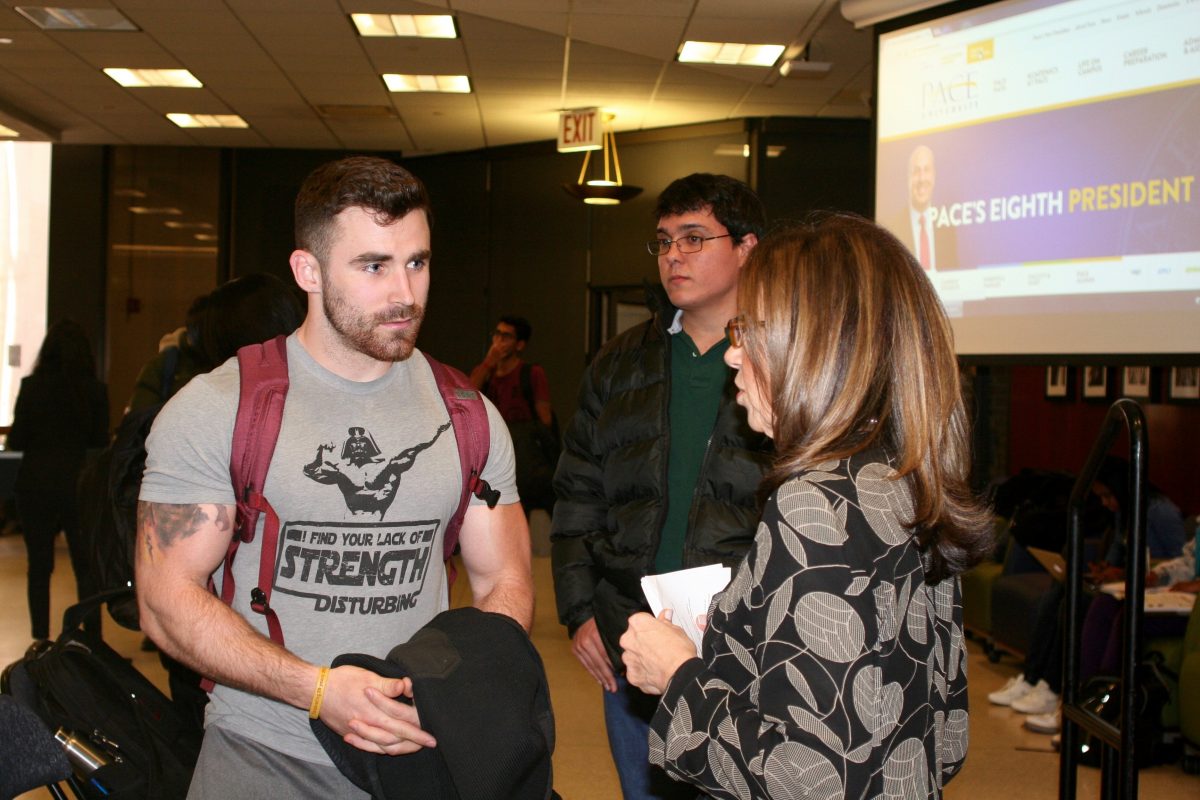The second of our LST Honoree Speaker Series took place on our Westchester campus. Butcher Suite was looking mighty full as a crowd of Pace students, staff, faculty, and our alumni and friends at IBM stopped by to listen to our spotlight day’s speaker, Nick Donofrio.
Similar to the previous LST Honoree speaker event with Judy Spitz, the format was interview style, with Seidenberg student Christian Nahshal (BS in Information Technology ’17) taking the stage alongside our guest. What followed was a fascinating conversation, where our 2013 LST Honoree, Nicholas Donofrio, shared his incredible insights, experiences, and wisdom.
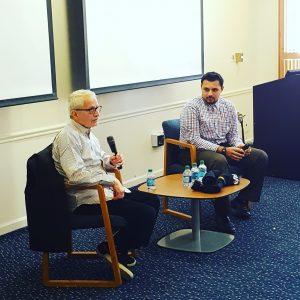 Nick Donofrio led IBM’s technology and innovation strategies from 1997 until his retirement in October 2008. He spent the early part of his career in integrated circuit and chip development as a designer of logic and memory chips. In the years that followed, he advanced and succeeded in numerous technical management positions and, later, executive positions in several of IBM’s product divisions. Notably, he was vice chairman of the IBM International Foundation and chairman of the Board of Governors for the IBM Academy of Technology.
Nick Donofrio led IBM’s technology and innovation strategies from 1997 until his retirement in October 2008. He spent the early part of his career in integrated circuit and chip development as a designer of logic and memory chips. In the years that followed, he advanced and succeeded in numerous technical management positions and, later, executive positions in several of IBM’s product divisions. Notably, he was vice chairman of the IBM International Foundation and chairman of the Board of Governors for the IBM Academy of Technology.
One of the first things Nick spoke about was what he gained from doing co-op assignments with IBM while he was at college. “I can’t say enough about co-op assignments, this idea of work study,” he said. One of the best things about doing relevant work while studying is that it helps cement theoretical learning with practical training.
As an engineer, it was useful to Nick to combine the two as it helped him learn to find solutions for specific problems. “You need to be more problem-based in the way you learn and the way you think, because that’s what engineers are.”
Nick also spoke about how important it was to get and maintain technical skills. Even though the higher up the ladder you go the fewer technical skills you typically use, it’s important to try to stay technical as long as you can.
He also introduced the concepts T-shaped and I-shaped personalities, and the importance of practicing the behaviors and traits of a T-shaped person. An I-shaped person is one that is an expert in one area and does not (and therefore cannot) solve problems outside of their field. However, if one takes the time to advance their knowledge in related areas, they spread their field of expertise – become T-shaped – and can apply a broader range of knowledge to solve different problems.
Expanding your area of knowledge also means you can connect two disparate ideas and create new things. “When you intersect things that don’t normally, or never have been intersected, you become an innovator,” said Nick. “It also allows you to explore the gaps,” finding new ideas within existing areas of knowledge.
“How do you bring that into a leadership aspect?” asked Christian, bringing the conversation around to Nick’s experiences in executive positions.
“Focus on how value is created, where, and how it is created,” Nick said. A good leader should see the strengths and weaknesses of their staff and assign them tasks and roles that allow them to work to their greatest strengths, individually and within the team.
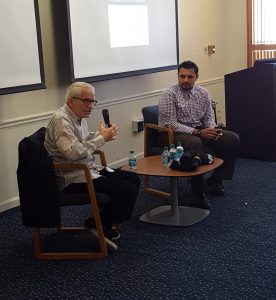 He also spoke about how important it is to be honest. “Transparency, openness, collaboration,” Nick said. If something goes wrong, it is always better to be upfront about it so a solution can be figured out sooner. “We’re going to find out the truth in the end anyway. Because that’s how it works. You may as well tell me now that you screwed up, that the project is 6 months late, that you’re not going to deliver, you might as well tell me NOW so I can help you.”
He also spoke about how important it is to be honest. “Transparency, openness, collaboration,” Nick said. If something goes wrong, it is always better to be upfront about it so a solution can be figured out sooner. “We’re going to find out the truth in the end anyway. Because that’s how it works. You may as well tell me now that you screwed up, that the project is 6 months late, that you’re not going to deliver, you might as well tell me NOW so I can help you.”
He shared a saying he likes to use: “You be forthright, I will be forthcoming. Tell me the truth; I will get you the resources.”
Christian then asked about what Nick considers to be one of the most important successes of his life.
“The impact I have had on the lives of people and the impact they’ve had on me,” Nick replied, explaining that the opportunities he has had to help other people have had a powerful effect on him, particularly the ability to lend an empathetic ear or be a sounding board. “To know the answer, but to know to listen is a very important gift.”
Nick is also a big advocate of paying it forward: “I want you to remember what I did for you and do something for somebody else. Too often, sadly, that does not happen. People get where they want to be, and the first thing they do is to lock the door. Don’t be that person.”
Several members of the audience then got to ask questions, which Nick happily answered, including a question about his experiences working with Steve Jobs. He described the kind of innovative thinking that enabled Steve Jobs to get to where he did: “Steve Jobs would solve your problems a different way. That’s what innovators do. He understand workflow better than anyone – that was what his gift was – and he would start with the problem. Any time he started with the answer he was wrong. He didn’t really create anything, he just studied it from the end user perspective.”
Another student asked “What qualities do you have that make you a T-shaped person?”
“You have to know your limits and your abilities, but that doesn’t mean you stop asking the questions,” Nick responded, and went on to recommend reading up on the Medici family who were around in Renaissance Florence. They were a very rich and powerful family who brought around the beginning of the industrial revolution. “They were T-shaped,” Nick said. “They thought about combining this craft with that craft,” which exemplifies the king of T-shaped thinking described above.
Bringing his point a little closer to the present day, Nick spoke about his time as a manager at IBM. “I didn’t know how to do a lot of things at IBM, but I would teach people how to teach themselves. T-shaped people are enablers, open, collaborative, multi-disciplined, global thinkers. They enable others to be better.”
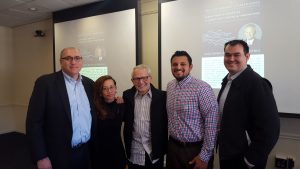
There was a final question – what was Nick’s favorite project?
“Probably the most embarrassing and the most rewarding,” Nick said. “When I became a manager back in the early 70s. I managed a group as the lead circuit designer. We were all friends. After a year, we had an opinion survey. For every group in IBM, you had the best and the worst. The best got rewarded by the chairman and the worst… we never heard from them again!”
When the survey results rolled around, Nick was dismayed to learn that he’d received a 1.2 out of 5 – from a team of people he considered his close friends. However, the more time he spent ruminating on his management style, the more he realized that perhaps he hadn’t been the best manager he could be. In fact, as his background had been doing the same job as the rest of the team, he realized that he’d spent the last year continuing to do that job, a job that wasn’t his any more.
“Now IBM wants me to go into a meeting with them and ‘find out why they think you’re a jerk, but you can’t outright ask them as the survey is anonymous’. I went into the meeting and told them, I am so sorry, I obviously let you all down. I know I must have been a jerk the last year, it’s clear to me that I was trying to do your job instead of my job. It’s clear to me that I may be fired. It’s also clear to me that if you’ll have me, I will change. I will be more collaborative, more open, the manager you want me to be. I will be a manager, not a circuit designer. To a person, they all agreed to keep me on.”
As luck would have it for Nick, there was one other person in the entire company with a score of 1.0, so Nick got to keep his job (it was decidedly unlucky for the other guy, though!)
“So my advice is that if you’re going to be bad, be bad early in your career!”
Following the Q&A, Nick stayed behind to chat with students and meet the community. We would like to thank Nick for spending an incredible couple of hours with us and for sharing the amazing stories and lessons he has learned over the years.
We hope to have you back soon! As Dr. Jonathan Hill, Dean of Seidenberg School remarked, “There is a reason why this gentleman fills a room.”
The final event in our LST Honoree Speaker Series will be held on April 19th, with guest speaker Austin A. Adams. RSVP here!
 Discussions with the panel were interspersed between screenings. Audience members were welcome to share their own experiences with disability, and many did. Films representing members of society that do not fit a particular mode are rare, and many people appreciated seeing themselves or their friends represented on the big screen.
Discussions with the panel were interspersed between screenings. Audience members were welcome to share their own experiences with disability, and many did. Films representing members of society that do not fit a particular mode are rare, and many people appreciated seeing themselves or their friends represented on the big screen. One of the great things about this particular event is the sense of community and support that fills the room as conversations are had and experiences are shared. The event is held in partnership with AHRC New York City and the ReelAbilities: New York Disabilities Film Festival. We encourage you to visit their websites and learn more.
One of the great things about this particular event is the sense of community and support that fills the room as conversations are had and experiences are shared. The event is held in partnership with AHRC New York City and the ReelAbilities: New York Disabilities Film Festival. We encourage you to visit their websites and learn more.


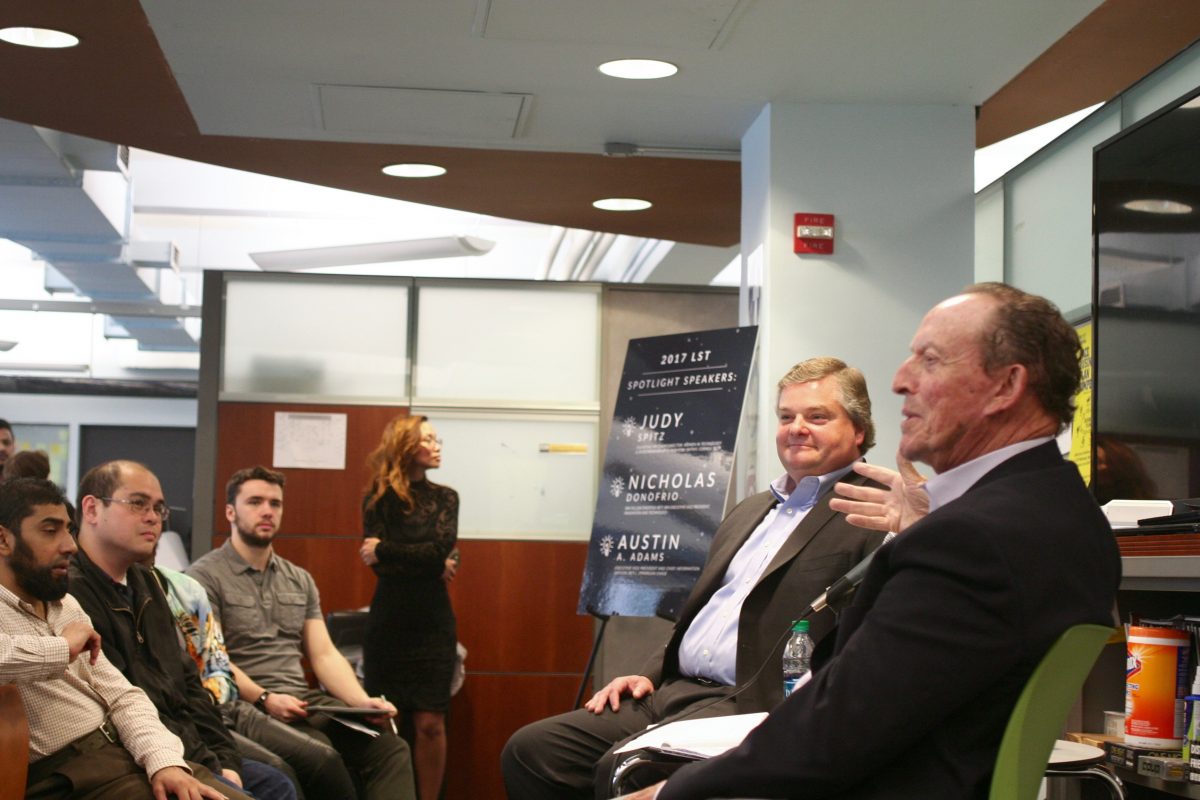
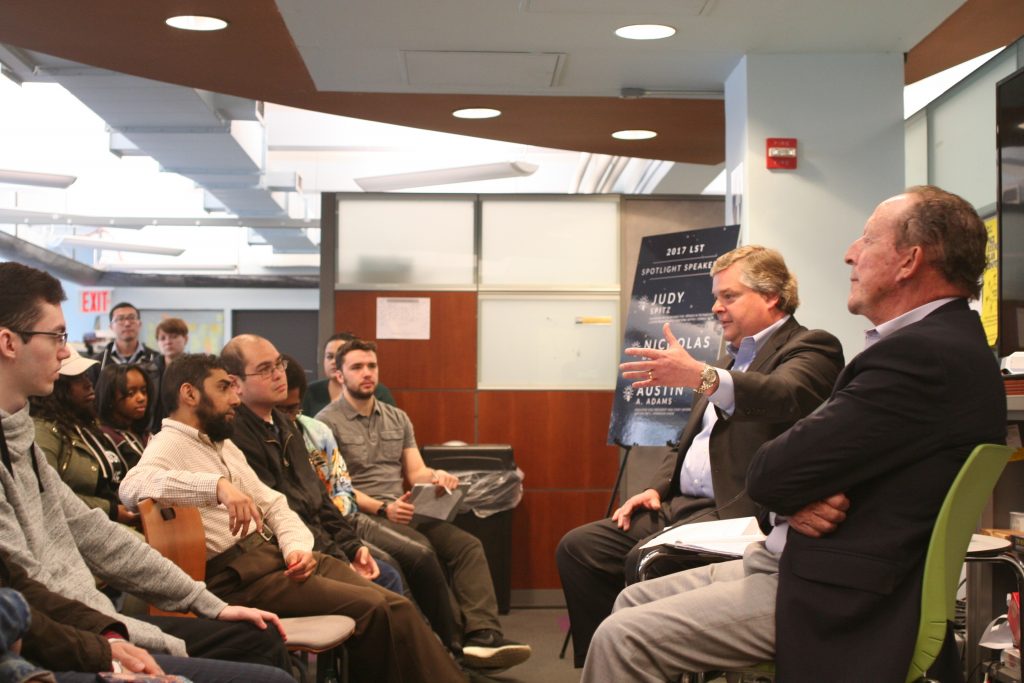
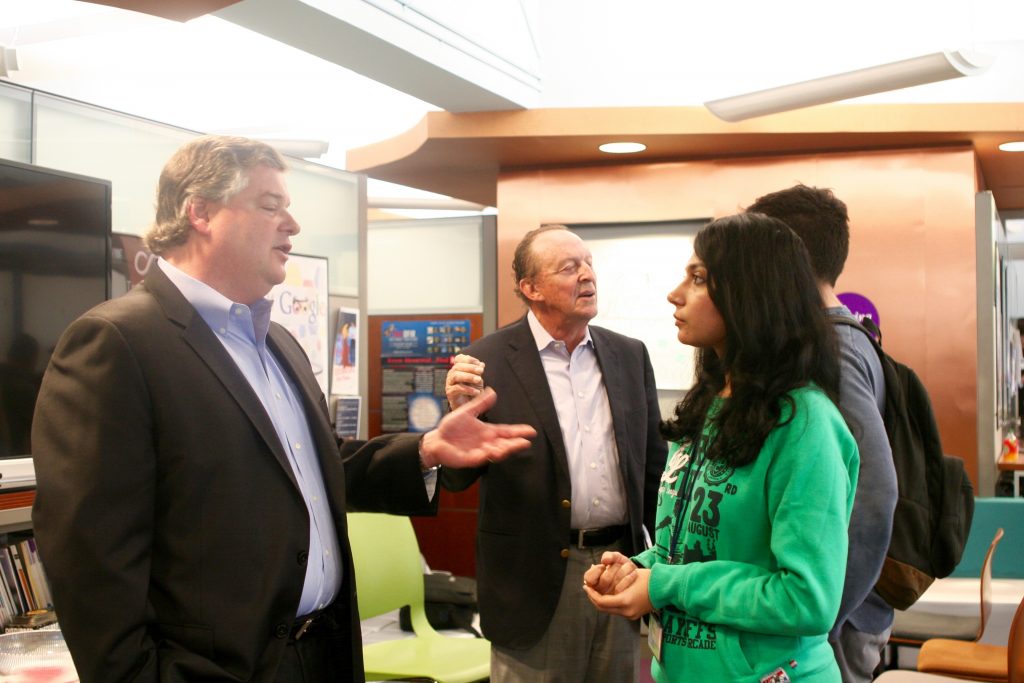
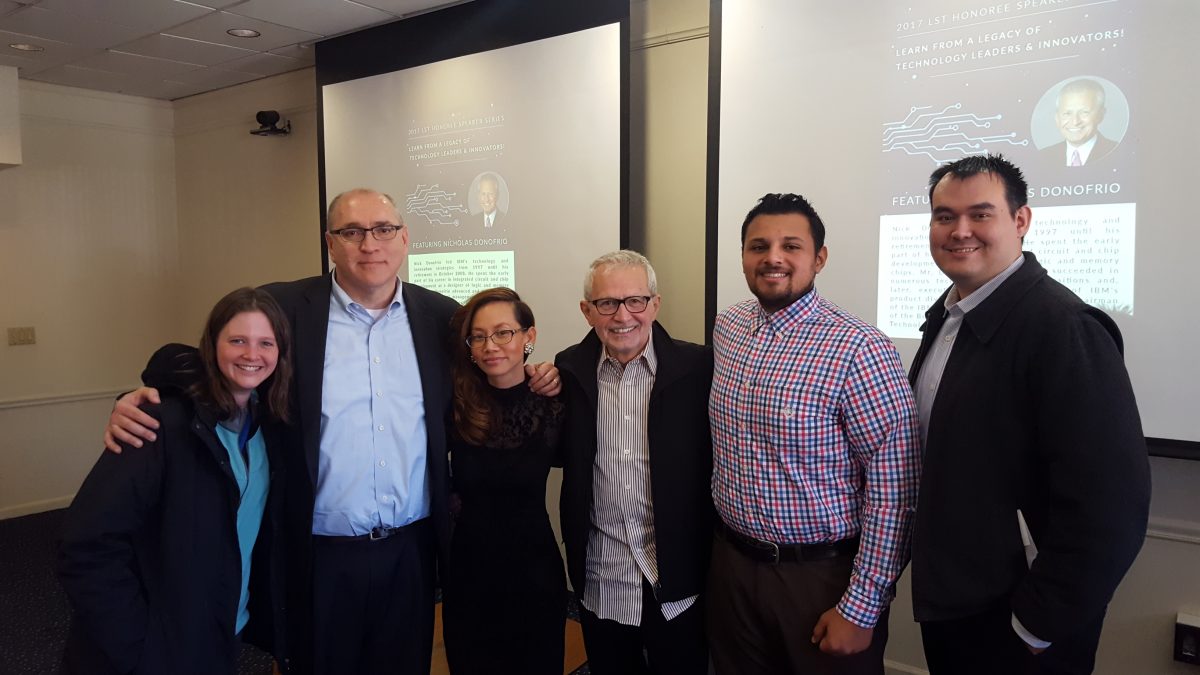
 Nick Donofrio led IBM’s technology and innovation strategies from 1997 until his retirement in October 2008. He spent the early part of his career in integrated circuit and chip development as a designer of logic and memory chips. In the years that followed, he advanced and succeeded in numerous technical management positions and, later, executive positions in several of IBM’s product divisions. Notably, he was vice chairman of the IBM International Foundation and chairman of the Board of Governors for the IBM Academy of Technology.
Nick Donofrio led IBM’s technology and innovation strategies from 1997 until his retirement in October 2008. He spent the early part of his career in integrated circuit and chip development as a designer of logic and memory chips. In the years that followed, he advanced and succeeded in numerous technical management positions and, later, executive positions in several of IBM’s product divisions. Notably, he was vice chairman of the IBM International Foundation and chairman of the Board of Governors for the IBM Academy of Technology. He also spoke about how important it is to be honest. “Transparency, openness, collaboration,” Nick said. If something goes wrong, it is always better to be upfront about it so a solution can be figured out sooner. “We’re going to find out the truth in the end anyway. Because that’s how it works. You may as well tell me now that you screwed up, that the project is 6 months late, that you’re not going to deliver, you might as well tell me NOW so I can help you.”
He also spoke about how important it is to be honest. “Transparency, openness, collaboration,” Nick said. If something goes wrong, it is always better to be upfront about it so a solution can be figured out sooner. “We’re going to find out the truth in the end anyway. Because that’s how it works. You may as well tell me now that you screwed up, that the project is 6 months late, that you’re not going to deliver, you might as well tell me NOW so I can help you.”
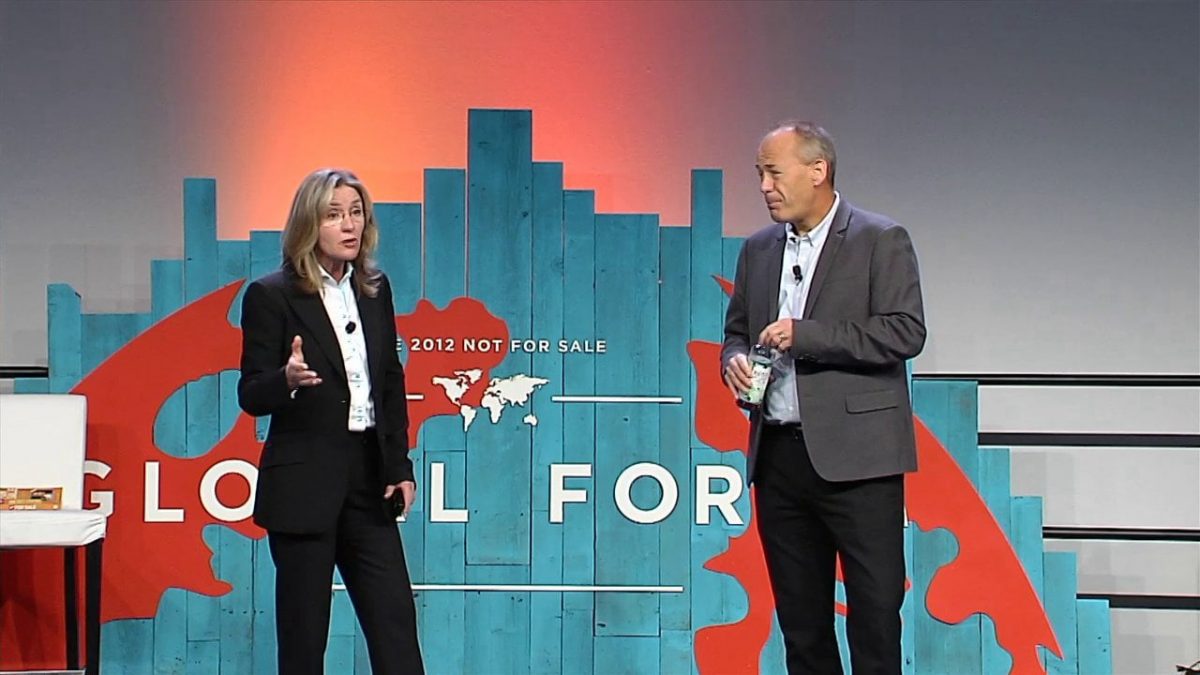
 I had been invited to dinner with a friend in Bermuda and met a young couple who were on holiday. The guy was in a startup and was friends with the CEO of iPhotonix. When the CEO was looking for a new board member, he reached out to me. I joined the board and, when the chairman left (his company was acquired and there was a conflict of interest), the shareholders asked me to be chairwoman. I did say no for about an hour and then they congratulated me! Case closed.
I had been invited to dinner with a friend in Bermuda and met a young couple who were on holiday. The guy was in a startup and was friends with the CEO of iPhotonix. When the CEO was looking for a new board member, he reached out to me. I joined the board and, when the chairman left (his company was acquired and there was a conflict of interest), the shareholders asked me to be chairwoman. I did say no for about an hour and then they congratulated me! Case closed. I started taking steps to change my behavior. Here’s an example: men talk to each other about sports, so I learned to play golf so I could have a conversation with them. I ended up loving golf so much I didn’t allow business on the golf course! And the men enjoyed playing with me so much it normalized our relationships. That allowed me to be seen as a person, rather than a woman who they couldn’t relate to.
I started taking steps to change my behavior. Here’s an example: men talk to each other about sports, so I learned to play golf so I could have a conversation with them. I ended up loving golf so much I didn’t allow business on the golf course! And the men enjoyed playing with me so much it normalized our relationships. That allowed me to be seen as a person, rather than a woman who they couldn’t relate to.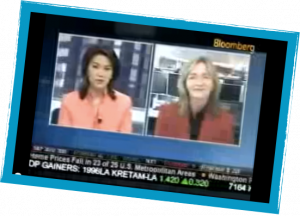 Breaking the mold is key
Breaking the mold is key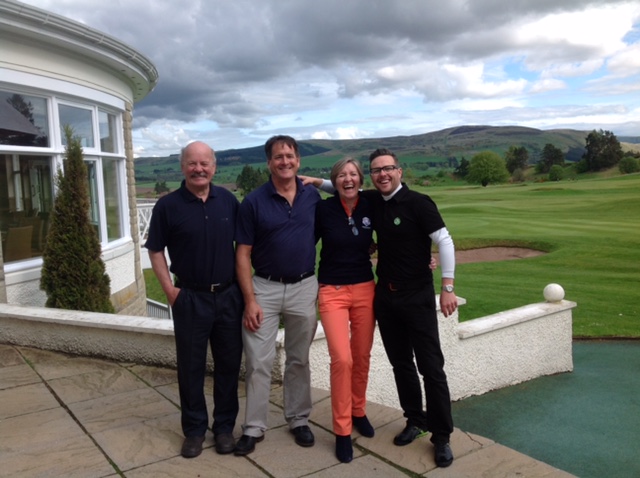
 Dave had a Montara Circle meeting of business, sports and government people to brainstorm ideas in 24 hours. They looked at the Peruvian Amazon where there are villages where whole families are indentured to collecting minerals used in the U.S. car industry. So we looked for something indigenous to the area that was also unique to the area and could be used for business. We discovered an herb called cat’s claw.
Dave had a Montara Circle meeting of business, sports and government people to brainstorm ideas in 24 hours. They looked at the Peruvian Amazon where there are villages where whole families are indentured to collecting minerals used in the U.S. car industry. So we looked for something indigenous to the area that was also unique to the area and could be used for business. We discovered an herb called cat’s claw. 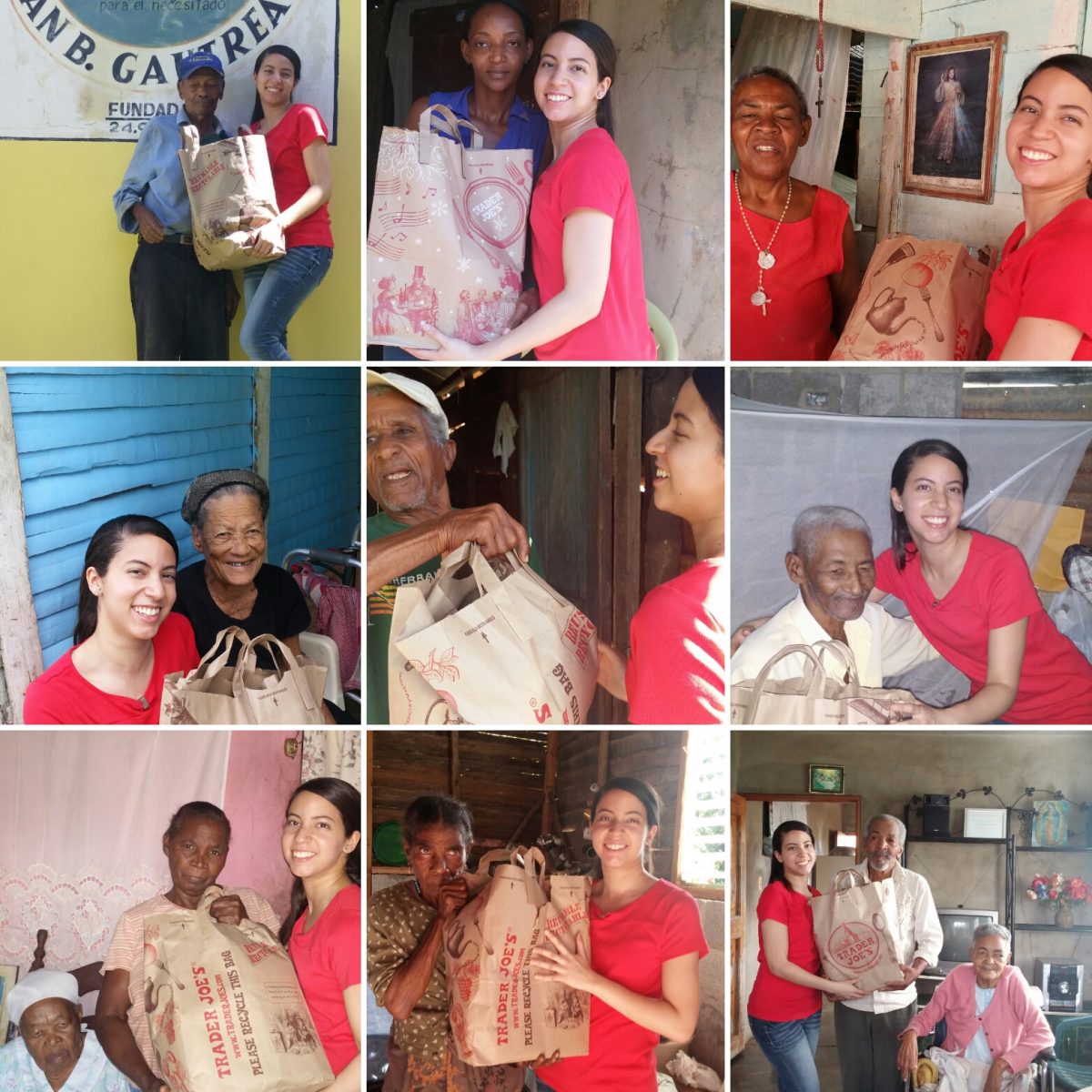
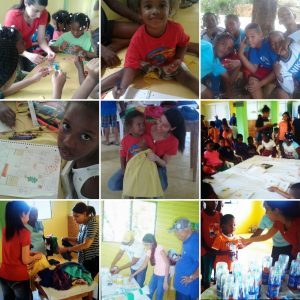 As a
As a 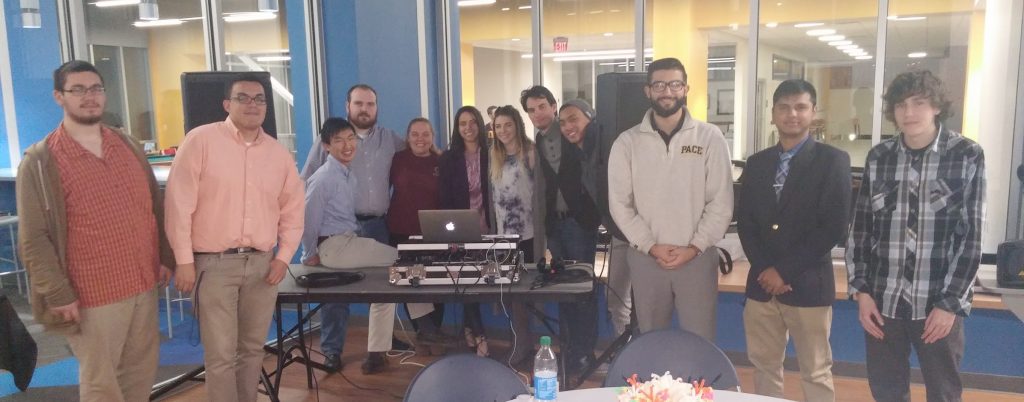 The Juan Bautista Gautreaux Foundation was founded by my grandfather in February, 2000, to provide assistance and health for those most in need.
The Juan Bautista Gautreaux Foundation was founded by my grandfather in February, 2000, to provide assistance and health for those most in need.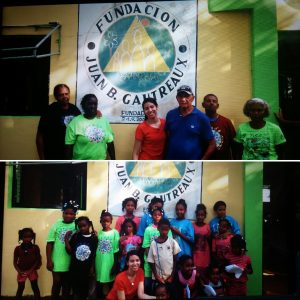 The community needs an act of healing and renewal so I have taken the time to listen, connect, and support those in most need through service this January 2017. Having contributed more than 400 hours of community service throughout my academic years, my natural desire and motivation to serve has grown stronger with this project.
The community needs an act of healing and renewal so I have taken the time to listen, connect, and support those in most need through service this January 2017. Having contributed more than 400 hours of community service throughout my academic years, my natural desire and motivation to serve has grown stronger with this project.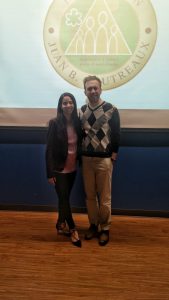 New York, Pace PLV Campus: The Benefit Dinner I hosted with my volunteers at the Kessel Multi-Purpose Room on November 13th, 2016, collected donations to bring relief to families in need in the Dominican Republic. Pace WPAW was the DJ of the event and there were four raffles as well. My mentor, Vincent Birkenmeyer (Vinnie), was a tremendous help for me to organize the event months in advance and I will always be grateful for his support. Vinnie and Pace Restaurant Sponsor with Pace Residence Life were able to provide the dinner. Donations of non-perishable food, toiletries, gently used clothing and shoes, as well as educational supplies for all ages, were accepted at this dinner and during tabling sessions (information sessions). Handcrafted accessories I crocheted were sold in exchange for donations. I made necklaces, scarves, headbands, and butterfly-bouquets.
New York, Pace PLV Campus: The Benefit Dinner I hosted with my volunteers at the Kessel Multi-Purpose Room on November 13th, 2016, collected donations to bring relief to families in need in the Dominican Republic. Pace WPAW was the DJ of the event and there were four raffles as well. My mentor, Vincent Birkenmeyer (Vinnie), was a tremendous help for me to organize the event months in advance and I will always be grateful for his support. Vinnie and Pace Restaurant Sponsor with Pace Residence Life were able to provide the dinner. Donations of non-perishable food, toiletries, gently used clothing and shoes, as well as educational supplies for all ages, were accepted at this dinner and during tabling sessions (information sessions). Handcrafted accessories I crocheted were sold in exchange for donations. I made necklaces, scarves, headbands, and butterfly-bouquets. 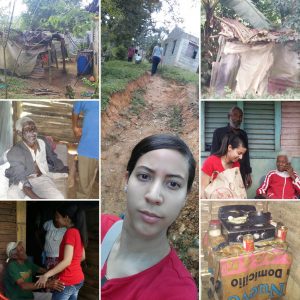 While walking on mountainous trails to bring food for those families in most need, my volunteers and I witnessed extreme living conditions, which include broken down outhouses made out of rags and twigs. We personally brought food packages to twelve different homes of elderly people and learned about their needs. The team and I visited the sick, blind, and injured. Many homes had no lighting and water for their homes. We met one elderly woman in her eighties who was missing a leg. Sadly, this elderly woman passed away in February 2017. Other people were suffering from osteoporosis, asthma, and depression. A bedridden and sickly man, father of two elderly sickly siblings, about 101 years old, smiled at us because he was so excited to have visitors stop by his room, a dark shack with sand and dirt for floors and dogs roaming around. His daughter was in tears because she was so happy that we came to bring her food.
While walking on mountainous trails to bring food for those families in most need, my volunteers and I witnessed extreme living conditions, which include broken down outhouses made out of rags and twigs. We personally brought food packages to twelve different homes of elderly people and learned about their needs. The team and I visited the sick, blind, and injured. Many homes had no lighting and water for their homes. We met one elderly woman in her eighties who was missing a leg. Sadly, this elderly woman passed away in February 2017. Other people were suffering from osteoporosis, asthma, and depression. A bedridden and sickly man, father of two elderly sickly siblings, about 101 years old, smiled at us because he was so excited to have visitors stop by his room, a dark shack with sand and dirt for floors and dogs roaming around. His daughter was in tears because she was so happy that we came to bring her food. Back on the site of my grandfather’s foundation, there were approximately 100 people from the community in need who showed up to receive donations. The team and I helped kids make Vision Boards so they can draw what they want to aspire when they grow up. We made sandwiches to feed everyone and gave out juice, distributed the donated clothes and toothpaste with toothbrushes. I taught young girls how to crochet as well so they can continue to build that skill to help their families. School bags with supplies were given to kids too. There was so much excitement and joy at this moment. Everyone who received their donation was so grateful to us and showed their gratitude with lots of hugs and smiles. It was incredible to see the huge positive impact we all created with combined efforts from NY and DR.
Back on the site of my grandfather’s foundation, there were approximately 100 people from the community in need who showed up to receive donations. The team and I helped kids make Vision Boards so they can draw what they want to aspire when they grow up. We made sandwiches to feed everyone and gave out juice, distributed the donated clothes and toothpaste with toothbrushes. I taught young girls how to crochet as well so they can continue to build that skill to help their families. School bags with supplies were given to kids too. There was so much excitement and joy at this moment. Everyone who received their donation was so grateful to us and showed their gratitude with lots of hugs and smiles. It was incredible to see the huge positive impact we all created with combined efforts from NY and DR. Poverty can be greatly reduced when people create dreams to strive for. My hope is that with this volunteer experience is that we helped developed courage, strength, and creativity in the lives of those in need so they can develop a better overall quality of life.
Poverty can be greatly reduced when people create dreams to strive for. My hope is that with this volunteer experience is that we helped developed courage, strength, and creativity in the lives of those in need so they can develop a better overall quality of life.